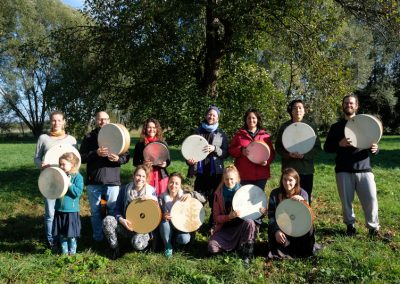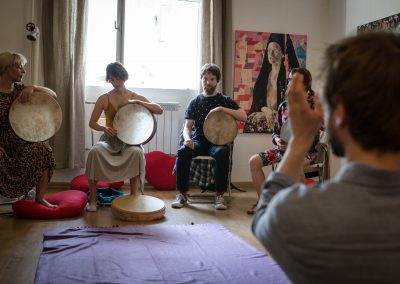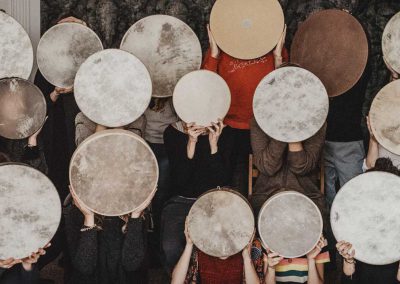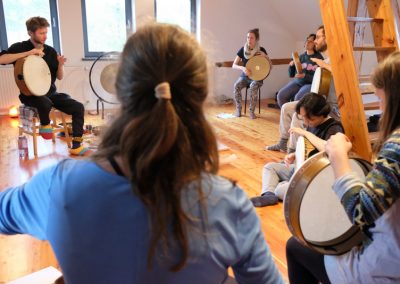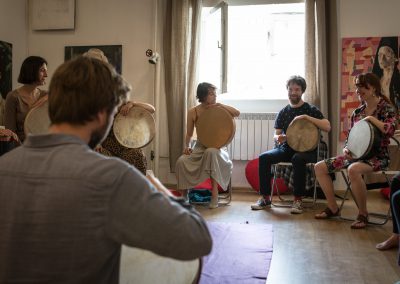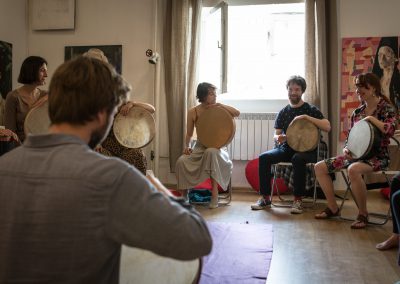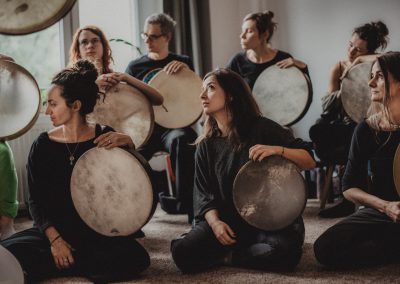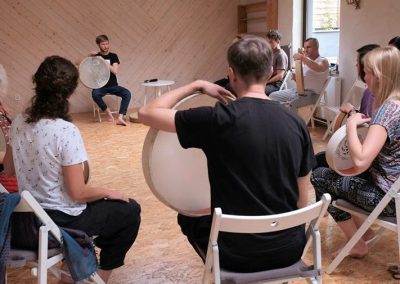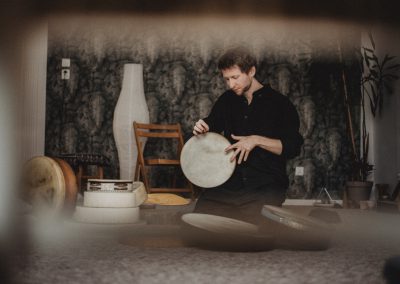about frame drums
WHAT IS THE FRAME DRUM?
By definition frame drum is a drum in which the diameter of the membrane is larger then the depth of the frame. The frame doesn’t have to be round (there are for example a square-shaped frame drums) and membrane can be made from variety of materials.
It’s one of the oldest instruments known to mandkind. Around the world it appears in different forms and is known under many different names.
In my artistic and teaching practice I focus on three instruments: modern ‘lap-style’ frame drum, modern ‘upright’ frame drum and riqq. These frame drums are common to many parts of the Mediterranean world and have different names depending on the region. I describe each of the techniques and instruments below.
The frame drum techniques I use have been developed by Israeli percussionist and composer Zohar Fresco. It is a modern approach to this instrument, in a great part inspired by different traditional playing styles and profoundly based on human anathomy and the ergonomy of movement. The rhythmology of Zohar Fresco has many links to rhythmology of Hindustani and Karnatic music. In 2020-2022 I also studied riqq from Yshai Afterman, a former student of Fresco.
A NOTE ABOUT NAMING
Frame drums are very widespread in different forms and under different names.. For example: Lap-style frame drum in some places is called bendir (for example in Turkey or Greece) while in Morocco (and other North African countries), bendir is an upright frame drum with a string attached to the back of the membrane. Other names for an upright frame drum in different places are: mazhar/mizhar, tar, daf or daire. For that reason I use these technical terms: ‘lap-style’ means that drum is resting on a lap, ‘upright’ or ‘upper-style’ – that it’s held up in the hands… Each of them is described below.
the drums/techniques I teach
Moddern upright frame drum
The drum is kept in the soft hand or in both (but usually with most of its weight on the left side in case of right-handed people). That’s typical a playing position in most of traditional frame drum playing styles: Indian Kanjira, Italian Tamburello, Northern-African Bendir, Greek Defi, Egyptian Mazhar, Kurdish Daf, Polish Bębenek, Tuvan shamanic drum etc.
‘Upright’ position alows you to walk or dance while playing the instrument. For me it’s an important feature – it feels good to play an instrument and dance at the same time; it’s also also an efficient way to practice independence and timing (for example by walking in an even pace while playing a rhythm). What is especially interesting for me in this technique, is the connection between body and instrument. The player’s position is not fixed, rigid; there is a constant movement, ‘a flow’ in favor of sound and ergonomy.
I usually recommend studying this technique before picking up riqq.
See an example of upright frame drum in my YouTube video.
Modern lap-style frame drum
See an example in my video.
The instrument rests on the left lap (in case of the right-handed people), with the left hand resting on the top of the drum and the right one remaining free. This way of using the frame drum has been developed only since 70’s and gained its widespread popularity quite recently. Two figures are especially famous for their their playing systems used in this position: Glen Valez from the US and Zohar Fresco from Israel. Both got inspired by techniques from different traditional percussions, both were interested in creating a technique that would make frame drum a self-sufficient solo instrument, both have studied Karnatic rhythmics.
This playing style is good to start with, especially if you are a complete beginner. In my experience it doesn’t take much time for students to learn the very basic techniques.
Apart from the basic strokes there’s a variety of advanced techniques in the Lapstyle Frame Drum, such as ‘snapping roll’, ‘split-hand’ or ‘rizz’. They enrich the sound and allow for fast and highly detailed playing.
Naming ‘issues’
Drum played in this position is sometimes called bendir or daf. However since these names designate completely different instruments in Morocco and Persia, I prefer to stay with a more ‘technical’ term.
How to choose an instrument for the lap-style?
There are two main things to consider: sound and comfort/ergonomy.
While sound is a personal question and every beginner should take time to understand what they need for kind of music they wanna play, there’s quite a lot to say about comfort/ergonomy. A drum with proper proportions, that fits your body size is a crucial factor for learning more effectively and with less physical problems. For an optimal comfort the drum resting on your lap should not reach higher then your collar bone – especially if you are a beginner. For most of us a diameter between 14 and 16 inches should be good. Otherwise, when you have to keep your left hand constantly above the level of collar bone, there is a tension appearing in your shoulder blade, shoulder and arm, which might lead to serious problems.
Regarding the depth of the frame for this technique – I don’t know any reason for it to be less then 10 cm wide, which is usually the case… The left hand (in case of right-handed people) and forearm need a place to rest on the frame and keep the whole instrument withoug unnecessary tension in the shoulder. Comfort of the hand allows it to be more mobile and effective. The ‘soft’ hand (left hand in case of the right-handed people) is as important as the ‘strong’ one, especially in more advanced playing. Working on development of the ‘soft’ side for most of us is already difficult by itself. It’s not worth making it even more frustrating by using a huge and shallow drum.
Following Zohar Fresco I recommend a frame of 13 cm deepness. The best option is a custom made instrument (contact me for hints on that!). There are also some stock-production drums available with at least 10 cm-deep frames (from Meinl and Schlagwerk).
Riqq
See an example here
Riqq (also known as riq, rek or… daf) is a type of tambourine usually with 5 pairs of brass jingles. It’s common to traditional and classical Arabic music. The membrane is usually fish, or nowadays – synthetic skin.
In many aspects Riqq resembles the ‘upright frame drum’. The main difference is that it includes jingles, which constitute another whole instrument to master. I teach a modern style of playing riqq, which I have been studying since 2010 from Zohar Fresco and since 2020 from Yshai Afterman.













